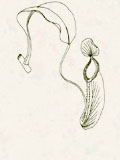
|
|
Vertebrates (pdf)
Newcomers to the local fish list, or unwelcome exotics!(pdf)
by Allen To and Anna Situ
The first fish to be added to the local fish list is the yellowtail tang, Zebrasoma xanthurum (Family: Acanthuridae), or so called "purple tang" among aquarists (Fig. 1). This beautiful reef fish was observed by Allen To and Kiwi Lee at Hoi Ha Wan Marine Park in mid-May. The tang was about 15 cm in total length and was hiding among rocks close to shore. This tang is documented to occur in the Western Indian Ocean (from Red Sea to the Persian Gulf) and the Maldives (Randall & Anderson, 1993).
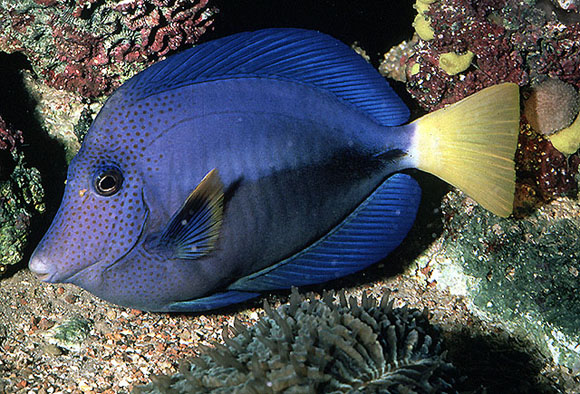 |
| Fig. 1. The yellowtail tang, Zebrasoma xanthurum. (Photo: John E. Randall). |
Another exotic fish, which is also an aquarist’s favourite, is the emperor angelfish, Pomacanthus imperator (Family: Pomacanthidae)(Fig. 2). That gorgeous 20 cm-adult angelfish was sighted in early June at Hoi Ha Wan Marine Park by Allen and Kiwi, in waters under the flyover to the education centre. This reef-associated angelfish was observed to be hiding within a crevice at a depth of about 1.5 m. It occasionally swam out of the crevice and looked curiously at us. Its documented distribution is in the Indo-Pacific (Red Sea and East Africa to Hawaiian, north to southern Japan, south to the Great Barrier Reef) (Fricke, 1999).
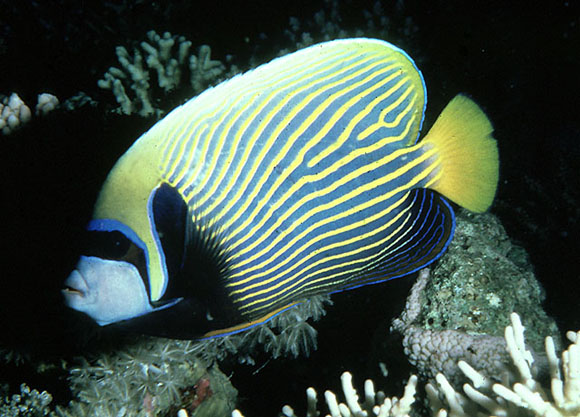 |
| Fig. 2. The emperor angelfish, Pomacanthus imperator. (Photo: John. E. Randall). |
A deep-sea fish, the pineconefish, Monocentris japonica (Family: Monocentridae) (Fig. 3), was collected by Allen, Anna Situ and Wallace Choi on 6 September from Ap Lei Chau Government Market. This specimen was about 6 cm in total length. This species had been described locally by another specimen reported to occur at Ching Chau in 2003 (hk-fish.net, 2004). Fishermen reported that the fish was caught in waters off Lamma Island. This species is characterized by its ability to give out light under its chin at night. Its documented distribution includes the Indo-West Pacific (Red Sea, South Africa, Mauritius to southern Japan) (Masuda et al., 1984; Smith 1986; Lieske & Myers, 1994).
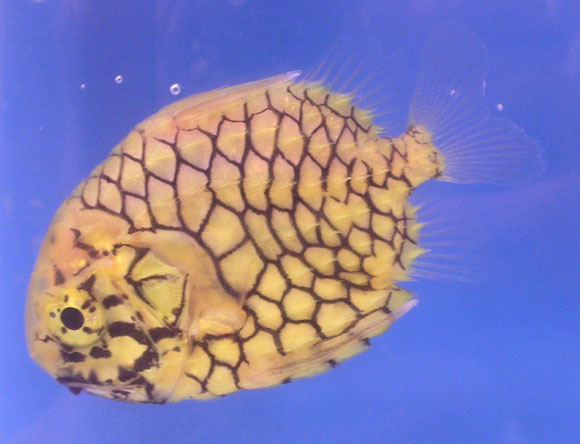 |
| Fig. 3. The pineconefish, Monocentris japonica. (Photo: Allen To) |
Last but not least is another surgeonfish, the humpback unicornfish, Naso brachycentron (Family: Acanthuridae) (Fig.4). The documented distribution of this fish includes the coast of East Africa to French Polynesia, Ryukyu Islands south to the Great Barrier Reef, the Philippines and Taiwan (Randall, 2001). This specimen was sighted in Sai Kung Market on 11 Oct 2004 by Allen, Anna and Wallace. Fishermen reported that they caught this specimen within Hong Kong but were unsure of the exact location. There has been no previous local documentation of this species.
Even though Hong Kong may fall within the documented distribution regions of the emperor angelfish, humpback unicornfish and pineconefish, there has been no known record of the first two fish species and only one recent record for the pineconefish locally. The yellowtail tang should not occur here according to its known natural distribution. In view of the increasing accessibility and popularity of aquarium fish, the most likely reason for the local record of the emperor angelfish and the yellowtail tang is from deliberate release; this might also be true for the pineconefish. People may release their fish because of sympathy, in the hope of good luck, health or even wealth. Large groupers, for instance, have often been released by local people for that reason. Marine parks such as the Hoi Ha Wan Marine Park might give the impression of being a "fish sanctuary" or "fish paradise" to those aquarists who were bored with their fish and would like to set them free in areas "ideal" to their fish. However, it is strongly recommended not to release fish into waters where they may not belong natually.
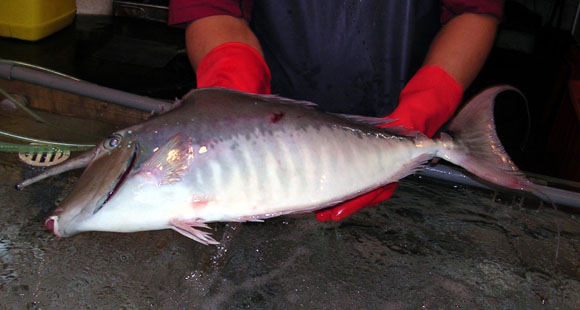 |
| Fig. 4. The humpback unicornfish, Naso brachycentron. (Photo: Allen To). |
Bibliography
Fricke, R. (1999). Fishes of the Mascarene Islands (Runion, Mauritius, Rodriguez): An Annotated Checklist, with Descriptions of New Species. Koeltz Scientific Books, Koenigstein, Theses Zoologicae, Vol 31: 759pp.
Hk-fish.net. (2004). New Records of Marine Fishes. Available from <http://www.hk-fish.net/eng/database/new_records/common.htm#> [Accessed 8 Oct 2004].
Lieske, E. & Myers, R. (1994). Collins Pocket Guide. Coral reef fishes. Indo-Pacific & Caribbean including the Red Sea. Haper Collins Publishers. 400pp.
Masuda, H., Amaoka, K., Araga, C., Uyeno, T. & Yoshino, T. (1984). The fishes of the Japanese Archipelage. Vol. 1. Tokai University Press, Tokyo, Japan. 437pp.
Randall, J.E. (2001). Surgeonfishes of The World. Mutual Publishing, Bishop Museum Press, Hawaii.
Randall, J.E. & Anderson, C. (1993). Annotated checklist of the epipelagic and shore fishes of the Maldives Islands. Ichthyol. Bull. of the J.L.B. Smith. Inst. of Ichthyol., 59: 47.
Smith, M.M. (1986). Monocentridae. In: Smith M.M. & Heemstra P.C. (eds) Smith’s sea fishes. Springer-Verlag, Berlin.
|
|
P.6-7 |
|
Porcupine! |
 Copyright © 2000 |
